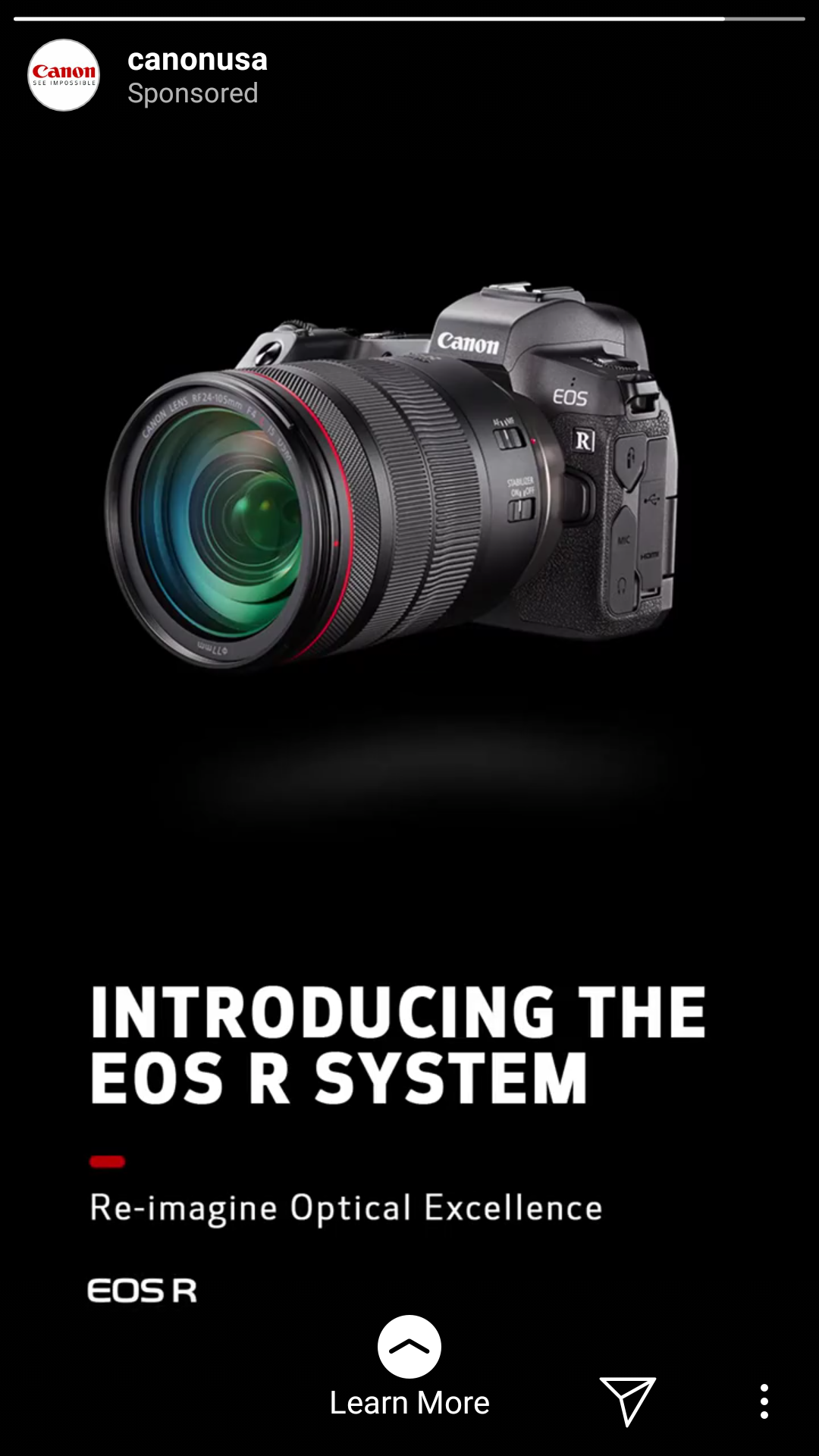Since Instagram’s creation in 2010, it’s grown by leaps and bounds. Right behind Facebook and YouTube, it’s now the third most popular social media platform in the U.S.
But if you thought Instagram was just for selfies and food photography enthusiasts, we’ve got news for you. It’s not just for personal use anymore. Instagram now helps business owners reach consumers with rich visual content. Some examples of Instagram ads for small business are photo ads, video ads, and shoppable posts.
Instagram rolled out its Stories feature in 2016, which allows users to share full-screen photos and video in one continuous stream. Stories then expanded to include business ads in 2017. Now, 1/3 of the most viewed Instagram Stories are from businesses.
Unlike regular ad posts, Instagram Stories for small business offers a chance to get up front and personal with audiences. That means you could be using Stories to engage consumers.
Not sure where to start? Learn about Instagram Stories ads, why your business needs them, and how to use them.
What are Instagram Stories ads?
See the circles at the top of your Instagram feed? These are Instagram Stories.

It’s important not to confuse Instagram Stories ads with Instagram post ads. While both are paid ads, their format is very different. Paid Instagram ads and shoppable posts appear as you scroll down your Instagram feed. Stories ads appear within Instagram stories at the top of your newsfeed.
Spotting Instagram Post Ads
Let’s go over how to spot an Instagram post ad first. Check out this one below from Imperfect Produce. Notice it appears much like a regular Instagram post. The word “Sponsored” right underneath the business name indicates it’s a paid ad. You’ll also see a call to action (“Sign Up”) at the bottom of the image.

Spotting Instagram Story Ads
Now, take a look below at this Instagram Story ad from Canon. You still see the word “Sponsored” right under the business name in the top left. But unlike the ad post above, this ad takes up the entire screen.

The main thing that sets Instagram Stories ads apart from Instagram post ads is how immersive they are. Because these ads occupy the whole screen, users’ attention is focused only on them.
Of course, there are a couple drawbacks. Instagram Stories ads run only for a maximum of 15 seconds, and then they “self-destruct” (or disappear). This means they don’t repeat for the same user after they’re shown, and there is no playback option. When they’re gone, they’re gone!
The basics of Instagram Stories ads:
- They’re mobile-first, meaning they’re designed primarily with mobile users in mind.
- They align with how users naturally hold their phones — vertically.
- You can use photo or video content in your ads.
- Consumers swipe up to visit your website or shopping portal.
Instagram determines with which users your ads are likely to perform best depending on your advertising objectives. But you control which devices your ads appear on, and you can determine your budget and scheduling preferences as well.
Why should small businesses use Instagram Stories ads?
You may not have the cash to create super fancy Instagram Stories ads like the one from Canon. And that might make you think, “Why bother?”
Not so fast!
Instagram Stories ads could help your business:
- Reach valuable mobile users.
- Establish a more personal connection with consumers.
- Tell stories in a more vivid and engaging manner.
- Drive more traffic to your website.
Pro Tip: Facebook owns Instagram, so you’ll need a Facebook Ads Manager account to create Instagram Stories Ads. You don’t need a separate Instagram account to create Stories Ads, though. If you do have an Instagram account, connect it to your Facebook ads account to get started.
Facebook also provides a handy guide to help you create Stories Ads in Ads Manager if you’re not already familiar with how to do so. We recommend bookmarking it to reference as needed.
How do you get the most out of Instagram Stories ads?
Before you get started creating ads, identify your main objective. Do you want consumers to buy something? Do you want them to check out a video on your website? Or do you want them to sign up to learn more about a service you offer?
Instagram Stories ads allow you to define your objectives when you create your ad.
7 different ad objectives to choose from:
- Conversions — Get consumers to take a desired action on your website.
- Brand awareness — Increase consumer recognition of your brand.
- Lead generation — Generate consumer interest in a product or service you offer.
- App installs — Direct consumers to install an app on their mobile device.
- Traffic — Gain consumer traffic to your website.
- Video views — Promote videos on your website for consumers to watch.
- Reach — Show your ad to as many people as possible.
Choose the objective you want to focus on, and use it to shape your Instagram advertising strategy.
We also recommend knowing who you want to reach with your ads. You don’t want to show them to audiences who aren’t likely to engage with them. When you create your Instagram Stories ad in Facebook Ads Manager, you’ll fine-tune your audience there.
Now, you’re ready to start creating your ads! Let’s go over some best practices to help you stay on track.
Be eye-catching.
Instagram, as we mentioned earlier, primarily caters to mobile users. Part of the shift toward mobile use is because we’re always on the go, busy multitasking. But that also means our attention spans aren’t what they used to be. Did you know the average human now has a 7 second attention span? Just for reference, that’s shorter than that of a goldfish!
Keep this in mind when planning your Instagram Stories ads strategy. If you want consumers to engage with you, you’ve got to get their attention and get it fast.
Eye-catching ads:
- Mention your brand within the first 3 seconds of your ad. Place your logo somewhere on the screen so it’s easy to see quickly.
- Use sound bites or music to draw in users.
- Start dialogue with consumers. Try creating a poll that entices users to answer. Even better, prompt them to swipe up to find the answer on your website.
- Maintain a sense of urgency. If you’re running a special on a product or service, include words like “limited-time offer” or “one day only.”
Get personal.
One of the appeals of Instagram Stories ads is the level of intimacy you achieve with consumers. Your ad doesn’t have to be perfectly polished to be effective. Brands can win over customers by just being real.
But what does that mean?
Consumers are more likely to trust you when you appear sincere and genuine. Think about when you’re talking to someone in person. Would you be likely to trust them if they weren’t looking at you or if you couldn’t see much of their face at all? Probably not.
It’s the same with your ads. Build consumer trust by putting a face to your brand and being relatable.
Inject realness into your Stories ads:
- Avoid over-producing your ads. Remember they’re inserted in between regular users’ Instagram Stories. Keep a seamless, non-salesy, organic feel.
- Use real, human faces. Try creating a Story ad starring you, and look into the camera as you speak. This creates a powerful connection with consumers.
- Repurpose user-generated content. Check your Instagram mentions, and share the best content in your Instagram Stories ads. It shows consumers you’re
- actually paying attention to what they’re sharing, too.
Be helpful.
One great way to increase your brand’s authority is to create helpful content within your Stories ads. If you only focus on sales pitches, consumers will eventually lose interest and swipe past your ads.
Think about ways you can help consumers. What knowledge do you have that could be useful to them?
Ideas for how to make your ads helpful:
- If you sell cosmetics, promote a makeup tutorial in your ad that consumers can view on your website.
- If you’re a plumbing service, promote a how-to guide on preparing exposed pipes for a winter freeze.
- Have an accounting business? Promote a list of common tax prep errors consumers should avoid.
If the content you want consumers to see is on your website, don’t forget to prompt users to swipe up so they can find it.
Being helpful in your Instagram Stories ads adds major value to your brand’s message. It also makes consumers more likely to trust you and therefore do business with you.






